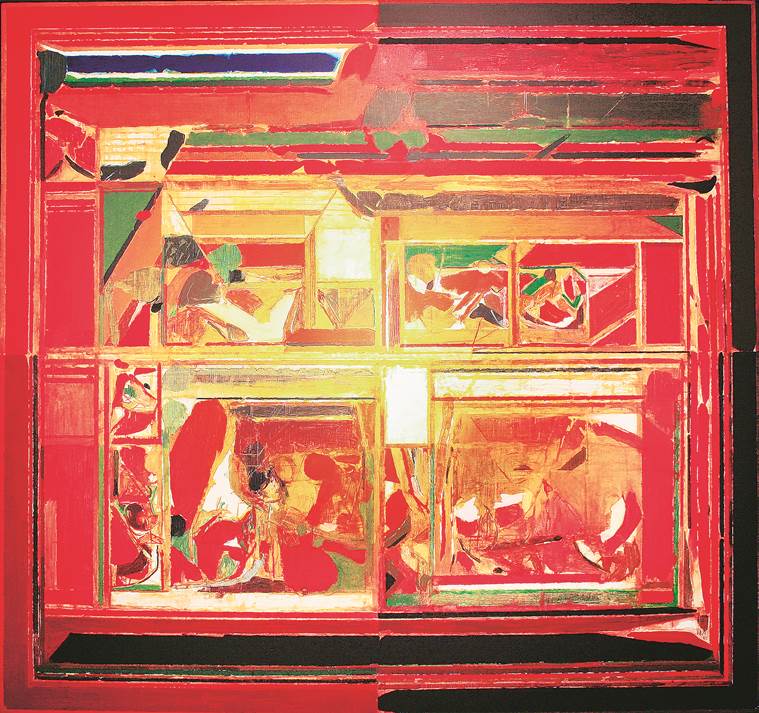Beyond the Bindu
In the first major exhibition of SH Raza’s works, since he died in 2016, visitors are given a glimpse into the artistic development of one of modern Indian art’s greatest icons

The artist’s portrait by an unknown photographer, 1960.
Everyone knows the story of how, when growing up in Mandla, Madhya Pradesh, SH Raza was introduced to the concept of the bindu by a teacher who wanted the young boy to learn how to focus. By the late artist’s own recounting, his teacher drew a bindu on the wall and told him to meditate on it and even though, as a child, he didn’t grasp its significance, the concept remained in Raza’s mind till the end. We think of this story every time we see one of his famed bindu works, which interpreted this childhood memory of the bindu as the shunya or the void, as well as the seed at the heart of creation. It’s this concept, in fact, that we’ve most come to associate with Raza, an artist who, like few others, managed to be at once Indian and international. “In the public mind, Raza is most identifiable with the period during which he engaged with the bindu,” says curator and art historian Vaishnavi Ramanathan.
So the big question that confronted Ramanathan and Ashvin E Rajagopalan, Director, Piramal Museum of Art, as they began working on ‘SH Raza: Traversing Terrains’, was whether it was possible to talk about the late artist’s journey in life without focusing too much on the bindu phase. “We wondered whether, if we chose not to highlight that period of his career, we would make it difficult for people to understand Raza and connect to his work,” says Ramanathan.
In the end, however, the curators focused on the earlier stages of the artist’s works, before he immersed himself in the bindu, and the exhibition is that much richer for it. Walking through the exhibition, the viewer gets a better idea of what it means to be an artist who is, as Ramanathan explains, constantly in search of a new language. “We’re trying to show, through this exhibition, how a good artist always evolves with time.”
The exhibition space, which has been designed by critically acclaimed exhibition designers Gallagher & Associates, is divided into four different sections, each of which focuses on different stages in Raza’s development. It starts with ‘Encountering the Urban’ (1940s), with Raza’s time at the Sir JJ School of Arts where he was a student from 1943 to 1947, and moving on to a wider engagement with the city of Bombay itself and his contribution to an aggressive, triumphant new modernism in Indian art through his founding role in the Bombay Progressives. The exhibition moves through the decades — ‘A New Terrain’ (1950s), ‘Departures and Roots’ (1960s to 1980s), and ‘The Return’ (1980s to 1990s) — all the while revealing the various artistic, literary and personal cross-currents that shaped Raza’s art. In fact, what makes the experience of ‘Traversing Terrains’ richer is the addition of footnotes in the form of letters that Raza exchanged with friends and collaborators in India and abroad, as well as photographs of the artist and works by those who formed a deep connection with Raza. When Raza travelled to Kashmir for a group show in 1948, for example, he met the photographer Henri Cartier-Bresson who told him that while his work was good, it lacked structure. A painting from this period — a still life — hangs in ‘Traversing Terrains’, as does a photograph that Cartier-Bresson shot of Raza in 1958 when the latter had moved to Paris and begun his immersion in the European traditions of abstraction.
With a tactile section that will allow visually challenged visitors to get a real sense of a Raza painting as well as a series of walk-throughs in Marathi and audio guides, ‘Traversing Terrains’ is designed to be as accessible to the public as possible. Moreover, since it is the first major exhibition of Raza’s works since the artist’s death in 2016, the museum has, in collaboration with the Raza Foundation in Delhi, drawn up a programme, with lectures, an evening of vernacular poetry and other discussions, that will celebrate the artist’s life and contribution to art and poetry. Ramanathan says, “Even though he lived outside India for so many years, Raza was deeply connected with Hindi poetry and he had set up the Raza Foundation to support young artists as well as poets. He was a multifaceted personality, equally at ease in French as he was in Hindi, and with a sound knowledge of Hindi and Western poetry as well as philosophy. We want our visitors to see him as he was — someone who nurtured and encouraged young colleagues, and who was driven by the restlessness of the true artist.”
‘SH Raza: Traversing Terrains’ is at the Piramal Museum of Art, Peninsula Corporate Park, Lower Parel, till October 28
For all the latest Lifestyle News, download Indian Express App






















 SH Raza, Rajasthan, 1983, Private Collection
SH Raza, Rajasthan, 1983, Private Collection
No hay comentarios:
Publicar un comentario